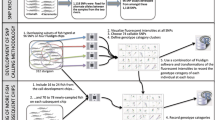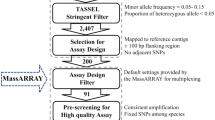Abstract
In many ecological field contexts, accurately classifying closely related species based on phenotypic characteristics may be difficult. In such cases, definitive classification of species may require expensive genetic analysis of tissues or extensive quantitative measurements. If inexpensive phenotype-based species classifications are highly correlated with expensive but definitive classifications, however, then estimating the proportion of a target species in a mixed species complex using a two-phase ratio estimator may prove cost-efficient. In two-phase ratio estimation, a first-phase sample is randomly selected, and phenotype is used to classify all individuals in the sample. A smaller, second-phase sample is then randomly selected from the first-phase sample, and a definitive method is used to classify the individuals in this subsample. Net relative efficiency (i.e., cost-effectiveness) of the optimally allocated two-phase ratio estimator of a proportion depends on the relative costs of classification at the first and second phases, on the phenotypic classification accuracy for the target species (sensitivity) and nontarget species (specificity), and on the magnitude of the target species proportion. Results are presented that allow assessment of the circumstances in which this two-phase estimation approach can be recommended over an equal-cost single-phase approach based only on expensive but definitive classification. An illustrative application of these methods is provided using an example of two closely related, sympatric, anadromous salmonid species: steelhead (Oncorhynchus mykiss) and coastal cutthroat trout (O. clarki clarki).
Similar content being viewed by others
References
Baker, J., Bentzen, P., and Moran, P. (2002), “Molecular Markers Distinguish Coastal Cutthroat Trout From Coastal Rainbow Trout/Steelhead and Their Hybrids,” Transactions of the American Fisheries Society, 131, 404–417.
Baumsteiger, J., Hankin, D., and Loudenslager, E. J. (2005), “Genetic Analyses of Juvenile Steelhead, Coastal Cutthroat Trout, and Their Hybrids Differ Substantially From Field Identifications,” Transactions of the American Fisheries Society, 134, 829–840.
Campton, D. E., and Utter, F. M. (1985), “Natural Hybridization Between Steelhead Trout (Salmo gairdneri) and Coastal Cutthroat Trout (Salmo clarki clarki) in Two Puget Sound Streams,” Canadian Journal of Fisheries and Aquatic Sciences, 42, 110–119.
Cochran, W. G. (1977), Sampling Techniques (3rd ed.), New York: Wiley.
Deming, W. E. (1977), “An Essay on Screening, or on Two-Phase Sampling, Applied to Surveys of a Community,” International Statistical Review, 45, 29–37.
Docker, M. F., Dale, A., and Heath, D. D. (2003), “Erosion of Interspecific Reproductive Barriers Resulting From Hatchery Supplementation of Rainbow Trout Sympatric With Cutthroat Trout,” Molecular Ecology, 12, 3515–3521.
Fleiss, J. L., Levin, B., and Paik, M. C. (2003), Statistical Methods for Rates and Proportions (3rd ed.), Hoboken, NJ: Wiley.
Gordis, L. (2000), Epidemiology (2nd ed.), Philadelphia, PA: W. B. Saunders.
Hankin, D. G. (1984), “Multistage Sampling Designs in Fisheries Research: Applications in Small Streams,” Canadian Journal of Fisheries and Aquatic Sciences, 41, 1575–1591.
Hankin, D. G., and Reeves, G. H. (1988), “Estimating Total Fish Abundance and Total Habitat Area in Small Streams Based on Visual Estimation Methods,” Canadian Journal of Fisheries and Aquatic Sciences, 45, 834–844.
Hawkins, C. P., Kershner, J. L., Bisson, P. A., Bryant, M. D., Decker, L. M., Gregory, S. V., McCullough, D. A., Overton, C. K., Reeves, G. H., Steedman, R. J., and Young, M. K. (1993), “A Hierarchical Approach to Classifying Stream Habitat Features,” Fisheries, 18, 3–12.
Jessen, R. J. (1978), Statistical Survey Techniques, New York: Wiley.
Lohr, S. L. (1999), Sampling: Design and Analysis, Pacific Grove, CA: Duxbury Press.
Love, M. S., Yoklavich, M., and Thorsteinson, L. (2002), The Rockfishes of the Northeast Pacific, Berkeley, CA: University of California Press.
McNamee, R. (2003), “Efficiency of Two-Phase Designs for Prevalence Estimation,” International Journal of Epidemiology, 32, 1072–1078.
— (2005), “Optimal Design and Efficiency of Two-Phase Case-Control Studies With Error-Prone and Error-Free Exposure Measures,” Biostatistics, 6, 590–603.
Ostberg, C. O., and Rodriguez, R. J. (2004), “Bi-Parentally Inherited Species-Specific Markers Identify Hybridization Between Rainbow Trout and Cutthroat Trout Subspecies,” Molecular Ecology Notes, 4, 26–29.
Ostberg, C. O., Slatton, S. L., and Rodriguez, R. J. (2004), “Spatial Partitioning and Asymmetric Hybridization Among Sympatric Coastal Steelhead Trout (Oncorhynchus mykiss irideus), Coastal Cutthroat Trout (O. clarki clarki) and Interspecific Hybrids,” Molecular Ecology, 13, 2773–2788.
Pollard, W. R., Hartman, G. F., Groot, C., and Edgell, P. (1997), Field Identification of Coastal Juvenile Salmonids, Madeira Park, BC, Canada: Harbour Publishing.
R Development Core Team (2008), R: A Language and Environment for Statistical Computing, R Foundation for Statistical Computing, Vienna, Austria. Available at http://www.R-project.org.
Sarndal, C.-E., Swensson, B., and Wretman, J. (1992), Model-Assisted Survey Sampling, New York: Springer.
Seber, G. A. F. (1982), The Estimation of Animal Abundance and Related Parameters (2nd ed.), New York: MacMillan.
Shrout, P. E., and Newman, S. C. (1989), “Design of Two-Phase Prevalence Surveys of Rare Disorders,” Biometrics, 45, 549–555.
Tenenbein, A. (1970), “A Double Sampling Scheme for Estimating From Binomial Data With Misclassifications,” Journal of the American Statistical Association, 65, 1350–1361.
Thompson, S. K. (2002), Sampling (2nd ed.), New York: Wiley.
Waples, R. S. (1991), “Definition of ‘Species’ Under the Endangered Species Act: Application to Pacific Salmon”, technical report, NOAA Technical Memorandum NMFS F/NWC-194, U.S. Department of Commerce.
Williams, T. H. (2004), “Geographic Variation in Genetic and Meristic Characters of Coastal Cutthroat Trout (Oncorhynchus clarki clarki),” PhD thesis, Dept. of Fisheries and Wildlife, Oregon State University, Corvallis, OR.
Wydoski, R. S., and Whitney, R. R. (2003), Inland Fishes of Washington (2nd ed.), Seattle: University of Washington Press.
Young, W. P., Ostberg, C. O., Keim, P., and Thorgaard, G. H. (2001), “Genetic Characterization of Hybridization and Introgression Between Anadromous Rainbow Trout (Oncorhynchus mykiss irideus) and Coastal Cutthroat Trout (O. clarki clarki),” Molecular Ecology, 10, 921–930.
Author information
Authors and Affiliations
Corresponding author
Rights and permissions
About this article
Cite this article
Hankin, D.G., Mohr, M.S. & Voight, H. Estimating the proportions of closely related species: Performance of the two-phase ratio estimator. JABES 14, 15–32 (2009). https://doi.org/10.1198/jabes.2009.0002
Received:
Revised:
Issue Date:
DOI: https://doi.org/10.1198/jabes.2009.0002




